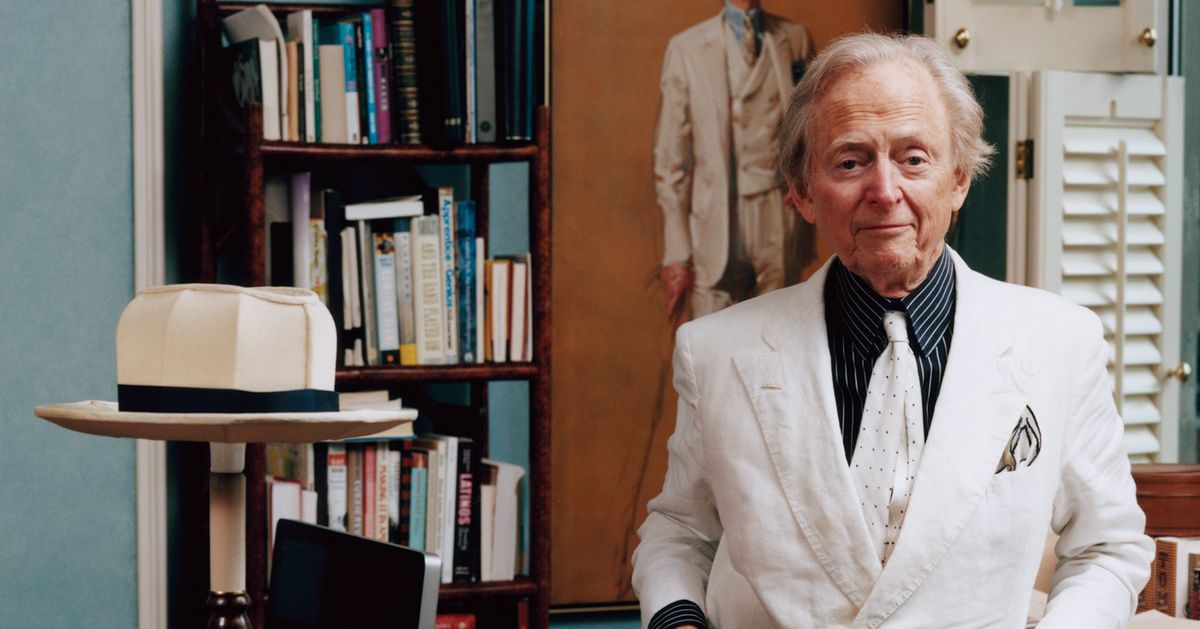
Photo: Tina Barney for New York Magazine, 2012
THIS!!!!! (all caps) was how Tom Wolfe, as the legend Wolfe propagated has it, wrote his proper magazine feature for Esquire in 1963, simply omitting the “Dear Byron” from the manuscript and organization the letter to his editor, Byron Dobell, he wrote in lieu of a tainted piece, about a custom-car convention in California, because he had writer’s stationary. In fact, in the end, the letter’s capital letters and the exclamation points were confined to the headline, in its full version: “There Goes (VAROOM! VAROOM!) that Kandy Kolored (THPHHHHHH!) tangerine-flake streamline baby (RAHGHHHH!) about the bend (BRUMMMMMMMMMMMMMMMM……” And today the piece reads like a aged, scene-by-scene piece of on-site feature journalism, its kitchiness largely a commercial of the inherent kitchiness of its subject matter. It’s voice-y and casual, but it rests on a fairly humble thesis, that the aged cars were “art objects” like the ones you’d find at Versailles or on St. Mark’s Square in Venice, and followed the same formula, “money plus slavish devotion to form.” “Naturally, most of the artifacts that these kids’ money-plus-form beget are of a pretty ghastly order. But so was most of the paraphernalia developed in England during the Regency.”
There’s his grad-student sensibility (Yale, American Studies) turned on pop culture before it was a pulling lots of grad students did, and the piece becomes an spend in what Wolfe would always do best: deflationary hype. Take the New Thing, point out the hypocrisy, vanity, and absurdity underneath it, and show that there’s nothing new understanding the sun after all. Christopher Hitchens said that Wolfe’s gift was fundamentally the adman’s, but it was a double gift: He always blew something up afore tearing it down. One exception to this rule: astronauts, although even they were gladiators in a new guise, those shiny space suits instead of suits of armor, but with the same potential widows weeping at home.
Now Wolfe is dead and one wonders what lustrous suit he’ll be buried in, because cremation wouldn’t do. Does anyone get buried in a white suit? There’s a whisper thread, through the phase with the exclamation points and capital letters, from the early Wolfe of the 1960s to the Wolfe who was apparently composed at work on a broadside against political correctness when the Reaper knock-knocked. It was a cartoonish nationalism that morphed from anti-communism (his dissertation at Yale was on communist manipulation of the League of American Writers during the Depression) to anti-Radical Chic (sniffing out hypocrisy and social awkwardness at the party for the Black Panthers in Leonard Bernstein’s apartment) to simple opponent to intellectuals (his 2000 essay for Harper’s “In the Land of the Rococo Marxists,” renewed in a book-length secondhand broadside alongside Noam Chomsky from 2016, The Kingdom of Speech).
There was a social grasped to his contrarianism, and it was that of the graduate student in exile from the academe and the Upper East Sider filing the minority relate from the cocktail party. It’s no accident that when the lustrous became ascendant politically Wolfe turned from journalism to fiction in the 1980s. Unlike Joan Didion, he couldn’t turn his jaundiced eye on both the hippies of Haight-Ashbury and the Reagan White House (though he was an expected guest there), and his famous “status radar” told him that the path to immortality grand be through the novel. This required not only writing novels but denouncing the entire field of American novelists, as he did in his 1989 Harper’s essay “Stalking the Billion-Footed Beast,” as a herd of quietists too disturbed to chronicle the berserk reality that was their birthright.
But the reason Wolfe’s novels never tossed (aside from their sometimes astronomical sales) as more than overlong film treatments is the same reason his journalism was a breakthrough. As a cartoonist and a hyperbolist, he made everything larger than life, and that can be a boon to journalism in a way that’s a liability to fiction — at least fiction that lasts, and lasts because it’s giving the culture something latest than a fun-house-mirror image of itself in a gallery of melodramatic scenarios with fine attention always paid to the decor. The roiling Atlanta of A Man in Full and the campus convulsions of I Am Charlotte Simmons might have continuing power if they had the truth status of nonfiction. Instead they’re the meanderings of a huffed-up, right-wing, second-rate Sinclair Lewis. Had Wolfe renewed the American social novel, then his inheritors would be Bret Easton Ellis and Jonathan Franzen, but both bypassed him for other models more gothic or cerebral. Garth Risk Hallberg’s 2015 City on Fire is a softened, backdated Bonfire of the Vanities and just as disposable. It was another softened disciple who was probably Wolfe’s most effective inheritor in spirit: David Brooks. The pop sociology of Bobos in Paradise wouldn’t have been possible minus Wolfe’s example. Despite many signs that he might like nothing better, Brooks has always been too savvy to trade in his credentials as a commentator and write a novel.
The revolution of the New Journalism was permanent. Whenever it seems to be subsiding, some new generation of writers will come inoperative and look to the resources of fiction and the freedoms of the pleasurable person to enhance their reporting and amplify their voices pending they’ve become successful enough to be tamed by the New York Times or The New Yorker. This was Wolfe’s great contribution, though one he community with Norman Mailer, Didion, Hunter Thompson, and a win of others. “Holy shit,” Thompson once wrote, ventriloquizing Wolfe, “if I can write like this and get away with it, why necessity I keep trying to write like the New York Times? It was like falling down an elevator shaft and inward in a pool of mermaids.”
